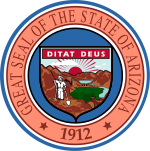1952 United States Senate election in Arizona
| |||||||||||||||||
| Turnout | |||||||||||||||||
|---|---|---|---|---|---|---|---|---|---|---|---|---|---|---|---|---|---|
| |||||||||||||||||
 County results Goldwater: 50-60% McFarland: 50–60% 60–70% 70–80% | |||||||||||||||||
| |||||||||||||||||
| Elections in Arizona |
|---|
 |
The 1952 United States Senate election in Arizona was held on November 4, 1952. Incumbent
On Election Day, November 4, 1952, Barry Goldwater defeated incumbent Ernest McFarland by a slim margin, winning by 6,725 out of approximately 260,000 votes cast, becoming the first Republican to win an Arizona U.S. Senate election since 1920. Goldwater, writing to Wisconsin Senator Joseph McCarthy, said of the results, "The election victory was not entirely a surprise, because we knew that McFarland, carrying the weight of Truman's mistakes around his neck, would have a difficult time winning, particularly in view of the fact that I had spent nearly all of my life campaigning for this job, whether I realized it or not."[3]
The election marked the end of the Senate career of Ernest McFarland, who was first elected in
This election would mark the beginning of a decades-long stretch of Republican electoral success in Arizona; Republicans would go on to continuously hold at least one of the state's Senate seats until 2020, when Democrats took control of both Senate seats in Arizona.
General election
Candidates
- Barry Goldwater, Phoenix City Councilman[5] (Republican)
- Ernest McFarland, incumbent U.S. Senator since 1941[4] (Democratic)
Campaign
After becoming a member of the Phoenix City Council in 1949,
Goldwater had been campaigning for several months before formally announcing his candidacy for McFarland's U.S. Senate seat on April 24, 1952. In his formal announcement, Goldwater cited six reasons for his entering the Senate race: his belief "that a life-long familiarity with the State of Arizona and its people and intensive study of the problems and needs of this region as a businessman and citizen qualifies me to represent efficiently our state in Washington,"[3] his opposition to the expansion of the federal government and belief in states' rights, his opposition to the New Deal and Fair Deal programs, his belief that a U.S. Senator should not be "a mere rubber stamp for any administration,"[3] and his opposition to the "present tragic trend toward the destruction of individual freedom."[3]
The
Originally believing he could run a campaign on his own with relatively few resources, Goldwater hired a campaign manager in June 1952,
Results
| Party | Candidate | Votes | % | ±% | |
|---|---|---|---|---|---|
| Republican | Barry Goldwater | 132,063 | 51.31 | +21.18 | |
| Democratic | Ernest McFarland (incumbent) | 125,338 | 48.69 | -20.49 | |
| Majority | 6,725 | 2.61 | -36.44 | ||
| Turnout | 257,401 | 82.28 | +23.65 | ||
Democratic
|
Swing | ||||
See also
- United States Senate elections, 1952
- List of United States senators from Arizona
- Electoral history of Barry Goldwater
References
- ^ a b "AZ US Senate". OurCampaigns. Retrieved August 2, 2012.
- ^ ISBN 0786402830.
- ^ ISBN 978-0230611337.)
1952 mcfarland goldwater.
{{cite book}}: CS1 maint: multiple names: authors list (link - ^ a b "McFARLAND, Ernest William, (1894 - 1984)". Biographical Directory of the U.S. Congress. Retrieved August 2, 2012.
- ^ a b "GOLDWATER, Barry Morris, (1909 - 1998)". Biographical Directory of the U.S. Congress. Archived from the original on June 25, 2013. Retrieved August 2, 2012.
- ^ "Foes of President Victorious at Polls". The Times-News. September 10, 1952. Retrieved August 2, 2012.
- ^ "AZ US Senate - R Primary". Our Campaigns. Retrieved August 2, 2012.



